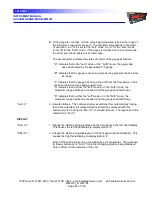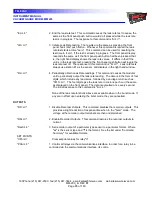
INSTRUMENT MANUAL
VACUUM GAUGE MODEL MM200
160Phone:(215) 947-2500 fax:(215) 947-7464 e-mail:[email protected] web site:www.televac.com
MM-200_im REV M
Page 91 of 160
TELEVAC
P. "RELAY MODULES (0 or 1), (0 or 2)". This indicates which relay modules, 1
and/or 2 are installed.
Q. "RECORDER FORMATS": The existing selected recorder formats are
indicated for all types of sensors whether or not those sensors are installed.
The format is described in easily understood English.
When the range of the sensor does not exceed three decades, this is usually
linear. When the range of the sensor is four or more decades, the standard
output is linear by the decade.
R. "STATIONS 1=(type) 2=(type) (and so forth)". This spells out the type of
sensor assigned to each station. If none are assigned, the response is "no", if
a station failed to be properly identified during initialization then the response
is "BAD". If a hot cathode gauge is installed, then only the first five stations
will be outputted, otherwise all ten will be outputted.
S. "RS485 ADDRS 'n' or 'l". This indicates the assigned RS485 address, which
may be a number or a letter. This address is case sensitive.
T. "SW Ver n.nn". This is the installed software version.
U. "24 VOLT ENABLE (ON or OFF)". This indicates whether control of model 3D
or 3E gauge filament control has been enabled by the software. If so then the
filaments cannot be turned on unless the 24 volt signal is available at the back
panel.
V. "24 VOLT SIGNAL (ON or OFF or N/A)." If the twenty-four volt input is
enabled, this output will indicate whether the 24 volts is applied or not. If not
enabled, this will be a N/A regardless of whether or not the 24 volts is applied.
W. "WATCH DOG (ON or OFF)." This indicates whether the watch dog is active
or not. It should always be active in normal operation.
X. "ZERO MODE (ON or OFF or AUTO)". This indicates the mode of zero
operation selected for certain types of gauges.
Y. The next line contains the zero and ATMOS offset values for the first eight
stations (whether applicable or not. (See the "OZ<cr>" command in
"Thermocouple, Convection, and Diaphragm Gauges" below).
Z. The next line (or two, if required) will indicate any faults that might be stored in
RAM. (See the "DP<cr>" command above).
















































